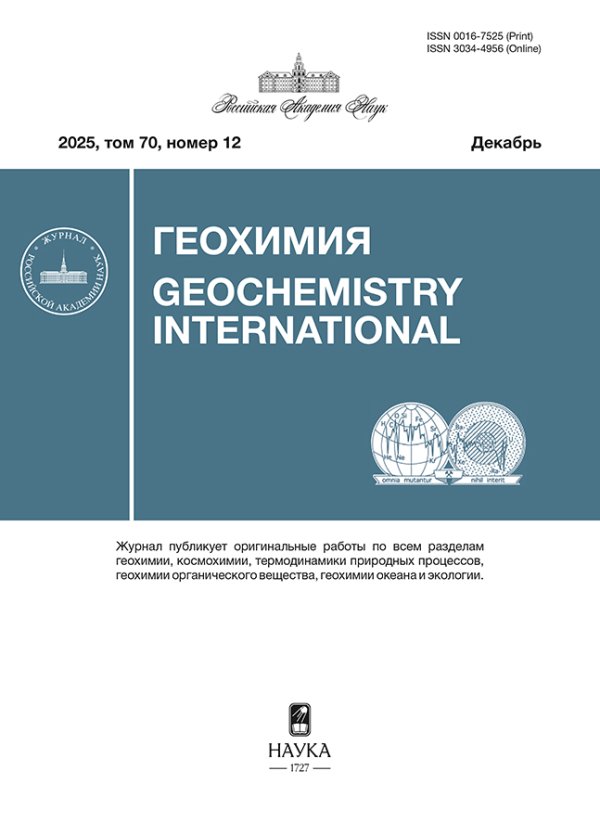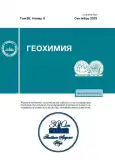Vol 68, No 9 (2023)
Articles
COMPOSITION OF PHENOCRYSTS OF LAMPROITE LAVA, GAUSSBERG VOLCANO, EAST ANTARCTICA
Abstract
This paper presents numerous new data on the geochemical composition of olivine, clinopyroxene, and leucite phenocrysts, as well as spinel inclusions in olivine and quench glass from lamproites of the Gaussberg Volcano (East Antarctica). Most of the olivine phenocrysts in the Gaussberg lamproites are high Mg varieties (Fo 89–91) with elevated Ni contents (up to 4900 ppm) and high Ni/Co ratios. According to the data of about 320 analyzes of clinopyroxenes, two groups of phenocrysts belonging to the diopside group have been established. Group I consists mainly of high-Mg varieties (Mg#>80), while group II clinopyroxenes are less magnesian (Mg# 52–80). The main difference between the clinopyroxenes of the two groups is manifested in the increased contents of Al2O3, FeO and reduced TiO2, Cr2O3, and NiO in the compositions of group II compared to group I, as well as different contents of trace elements, which may reflect their crystallization from different types of primary melts. According to the study of about 550 grains of leucite phenocrysts in Gaussberg lamproites, it was shown that they correspond to the ideal stoichiometry of leucite K[AlSi2O6] and are enriched in Na2O (0.05–0.35 wt %), but depleted in K2O (19.9–20.9 wt %) compared to with leucites from lamproites of other provinces. The BaO content reaches 0.3 wt %. %, SrO –0.04 wt. %. The iron content in most leucite phenocrysts varies within 0.7–1.2 wt % Fe2O3, with individual grains with low Fe2O3 contents (<0.5 wt %). In microlites of leucite in the groundmass and rims of phenocrysts, the iron content can reach 2.4 wt % Fe2O3, which may indicate more oxidized conditions at the time of lava eruption.
Based on the study of natural samples, existing experimental data and computational models, the order and conditions of crystallization of Gaussberg lamproites were restored. Crystallization proceeded in the following order: chrome spinel -> chrome spinel + olivine -> olivine + leucite (± chrome spinel) -> olivine + leucite + clinopyroxene (± chrome spinel). The near-liquidus association, represented by high-Mg olivine phenocrysts with inclusions of Cr-spinel, was formed in the temperature range from 1180 to 1250°C. Further crystallization of the melt with the formation of an association of olivine+leucite+clinopyroxene phenocrysts could occur at pressures below 2 GPa and temperatures of 1070–1180°C, corresponding to the presence of water in the magmatic system. Estimates of the redox conditions of crystallization of lamproites, obtained using different oxybarometers, vary in a wide range from QFM-0.5 to QFM+2.3.
Elevated Ni contents in liquidus olivines of Gaussberg indicate high nickel contents in the source. It is shown that the possible formation of ultraalkaline magmas in the region of Gaussberg Volcano occurred during the melting of the continental lithosphere, which was heterogeneous and included both the peridotite mantle and hydrous pyroxenite fragments.
 897-925
897-925


Equation for Calculation of Saturated Water Contents in Silicate Melts: New Version
Abstract
On the basis of literature sources, a sample of experimental data was formed. The sample contains the results of 394 hardening experiments characterizing the saturated water content in a wide range of intensive parameters of silicate systems. An analysis of the main published types of models of water solubility in a silicate melt showed that the equation of Gordon Moore et al. best describes the experimental results.
The Moore equation, converted to exponential form, is recalibrated on an extended experimental sample. As a result, new coefficients for this equation are obtained: a = 918; bAl2O3 = – 0.712; bFeO = – 0.749; bNa2O = 0.806; c = 1.087; d = -11.45. The Moore equation with new coefficients makes it possible, with an error not exceeding ±1 - ±2 relative percent, to predict the saturated water content in silicate melts in the range: melt compositions from basalts to rhyolites; pressure from atmospheric to 15 kbar; temperatures from 550 to 1300 °C.
 926-937
926-937


Partitioning and speciation of lanthanides in the system magnetite (hematite) – hydrothermal solution at 450 oC and 100 MPa pressure
Abstract
The initial results of the experimental study of a hydrothermal system including lanthanides (Ln) and Fe oxides (magnetite and hematite) are presented. Ln concentrations in solutions and crystals were determined by ICP-MS and LM-ICP-MS, accordingly. The Ln distribution and cocrystallization coefficients obtained are interpreted as the maximal estimates of “true” values corresponding to structurally bound admixture. It is shown that Ln (except for Eu) are the compatible elements in hydrothermal magnetite; heavy Ln (beginning with Tb) are compatible in hematite. The pronounced tendency of the elevation of both coefficients with the Ln atomic number beginning from Gd-Tb was established. This is significant for using the ratio of light and heavy Ln as a typochemical guide for localization of the source of ore elements. The high-Ln-containing phases in associations with magnetite and hematite were obtained. These phases have oxychloride (without Fe) and oxyhydroxide (with Fe) composition and demonstrate the example of co-locating light and heavy Ln in the common space of hydrothermal system due to mutual crystallization of the phases selectively accumulating light and heavy lanthanides.
 938-946
938-946


GEOCHEMISTRY OF HIGH-PHOSPHORUS ZIRCON FROM THE UPPER RIPHEAN METASANDSTONES OF THE SOUTHERN TIMAN
Abstract
A detailed mineralogical and geochemical study (using the EPMA and SIMS methods) of zircon from metasandstones of the Dzhezhim Formation in the South Timan made it possible to establish an anomalously high content of phosphorus in it (up to 10.27 wt % P2O5 according to EPMA data), which correlates with an increased content of other non-formula admixture elements, the main of which are Y, REE, Ca, Fe, Al, Ti, Sr, Ba, Th, U. Of particular note is the significant amount of volatile components in zircon (up to 0.49 wt % water and up to 0.26 wt.% fluorine, determined by the method SIMS). The total content of non-formula admixture elements can exceed 20 wt %, which is a characteristic feature of the composition of zircon exposed to fluid or formed as a result of hydrothermal-metasomatic processes. The main mechanism for the incorporation of admixture elements into the composition of zircon was xenotime-type heterovalent isomorphism, when the presence of quinquevalent phosphorus is compensated by the participation of trivalent Y and REE. Of subordinate importance was the isomorphism scheme, which ensures the entry of hydrogen (water). The areas of zircon enriched in phosphorus and other adulterants are confined to the edge of the grains, or to systems of scissures and fluid-permeable areas. Granitoids served as a possible source of zircon, and the process of transformation of its composition (recrystallization and enrichment of local areas, less often whole grains) probably occurred already in the sandstone sequence, during metamorphism and/or hydrothermal process.
 947-963
947-963


HYDROCARBONS IN LITTORAL SEDIMENTS AND MARCH SOILS OF THE SOUTHWESTERN COAST OF THE BARENTS SEA
Abstract
According to the results of GC-MS study of the composition and distribution of hydrocarbons (n-alkanes, isoprenoids, steranes, hopanes, polycyclic aromatic hydrocarbons (PAHs) and their alkyl homologues), the genesis, facies conditions of sedimentation, the degree of transformation of organic matter of bottom sediments and marching soils of the southwestern coast of the Barents Sea are characterized. The assessment of the toxicity levels of polyarenes on the biota inhabiting the tidal zones of the coast was carried out. Areas with increased anthropogenic load have been identified (littoral of the eastern Tana Fjord, the village of Kiberg, Abram Cape, the village of Mishukovo, the mouth of the Kulonga River, the apex part of the Yarnyshnaya Bay, Oscar Bay), indicating the unfavorable ecological state of the tidal zones of the Barents Sea coast.
 964-981
964-981


DETERMINATION OF THE TRACE ELEMENT COMPOSITION OF BLACK SHALE ROCKS AND ORES. CERTIFIED REFERENCE MATERIALS OF SLg-1 AND SChS-1
Abstract
A set of methods for studying the trace element composition of black shales has been developed, including various options for preparing samples for analysis to determine individual groups of elements, including PGE and gold, by atomic spectroscopy methods (ICP-AES, ICP-MS, ETAAS). Data on the content of 54 elements in certified reference materials (CRMs) of black shale rocks SLg-1 and SChS-1 were obtained. The metrologically characterized data will make it possible to use these CRMs for a detailed study of the composition of rocks and ores containing carbonaceous matter. The relevance of the problem is due to the absence of natural multi-element CRMs, in which elevated and clarke contents of gold, silver, as well as all PGEs, are simultaneously certified.
 982-992
982-992












